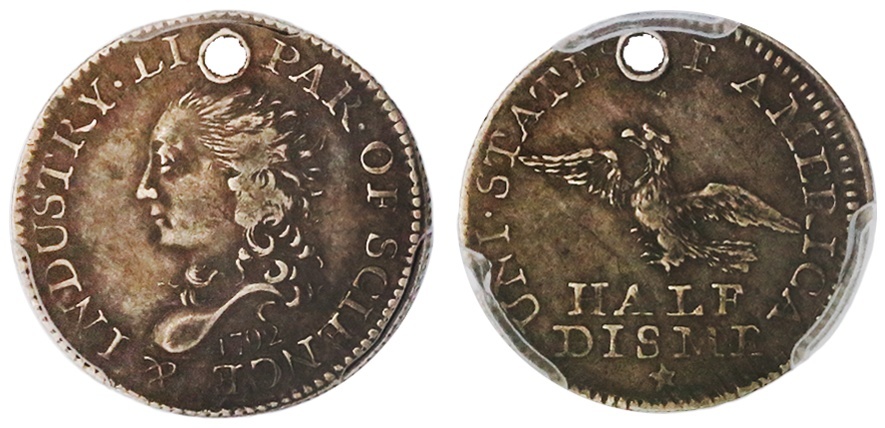
Auction: 332 - The Numismatic Collector's Series Sale
Lot: 256
1792 Half Disme. LM-1. Judd-7. Pollock-7. The obverse, above the 1792 date, is the head of a woman representating Liberty. "LIB PAR OF SCIENCE & INDUSTRY" (Liberty, Parent of Science and Industry) circles the entire obverse. The main device on the reverse is an eagle, facing left, with the denomination,"HALF DISME'" below. The reverse is circled by the motto "UNI. STATES OF AMERICA." Beneath the denomination is a five-pointed star. PCGS Genuine. Holed - VF Details.
"Legendary." "Historically important." "Ground breaking." "Controversial." These words all apply to this diminutive, but truly significant issue.
The legend of the 1792 Half Disme is the stuff from which Broadway shows and Hollywood movies are made. In 1792, Thomas Jefferson came to George Washington with a diplomatic problem. Jefferson told Washington that visiting foreign dignitaries often presented him with sets of coins representing the countries they came from. The dignitaries returned home thinking "What kind of a country is it that does not have its own coins?" Washington was aware that Congress had already authorized coins to be minted, and wondered what was delaying the process. He looked into the situation and soon learned that the Mint building was under construction but not yet ready for business. He was told that coin presses were sitting in the basement of a building in Philadelphia. An Acting Chief Coiner was appointed, and he was asked to strike the coins in the basement. Now, only one major obstacle had to be overcome - there was no silver in the U.S. Treasury. George and Martha Washington discussed the matter and the decision was made to have their personal silverware deposited into the Treasury. Shortly thereafter the first officially authorized United States coins were minted (an 1815 painting by John Ward Dunsmore entitled "Washington Inspecting the First Money Coined by the United States" shows George and Martha Washington, Thomas Jefferson, Alexander Hamilton and Mint Director David Rittenhouse observing the striking of the first U.S. coins, though the actual event cannot be documented). Thomas Jefferson now had what he needed to assure any visiting diplomats and dignitaries that the United States was a real country.
What really happened? We know from Washington's address to Congress on November 6, 1792 that the U.S. Mint was not yet in operation, confirming that the coins had to be struck elsewhere. We know that Thomas Jefferson actually received 1,500 of these coins (according to his own household account book. The entry, dated July 13, 1792, came just four days after Washington granted written authorization to have the coins struck). Retired Chief Coiner Adam Eckfeldt, who was present when the coins were struck, later verbally reported that $100 in bullion or specie was deposited by George Washington into the Treasury for the purpose of minting these coins.
What is the historical significance of this issue? The 1792 Half Disme established for all time that the United Stated was committed to using the decimal system for its coins. In an experiment to simplify accounting in this country, Congress decided that the dollar would be equivalent to one hundred cents.
Are the 1792 Half Dismes really coins, or just patterns? The fact that many of the surviving examples known today display a good deal of wear indicates that many were placed into circulation. In Washington's address to Congress on November 6, 1792 he stated "…There has been a small beginning in the coinage of half dismes, the want of small coins [author's emphasis] in circulation calling the first attention to them…" If George Washington himself referred to the half dismes as "coins., then who are we to say otherwise? Our example is fresh to the market, and recently certified. The strike is bold, the surfaces are original, and the coin is undeniably genuine. Determining an accurate value is, of course, complicated by the presence of a 2mm hole at the top of the coin. A comparable example, graded PCGS Genuine, Very Fine Details, Contemporary Hole, brought $38,525 against an estimate of $15,000 to $25,000 in Scotsman's October 18th, 2013 auction in St. Louis, but past performance is no guarantee of future results. We will estimate this lot very conservatively and let the bidders decide what the coin is worth in today's market. Estimate $10,000-15,000
Sold for
$15,500




